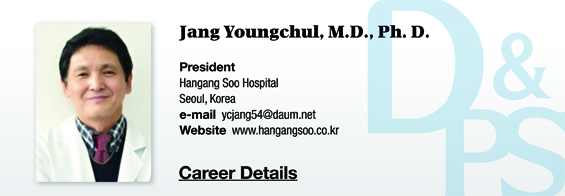▶ Previous Artlcle : #9-1. Factors involved in wound healing
FGF
FGF is a series of ten heparin-bound growth factors on which a large volume of literature exists. It functions as an angiogenesis factor that stimulates growth of new blood vessels through capillary endothelial cell proliferation. It also promotes proliferation of epithelial cells with a potential for endothelial cell mitogen.
[Advertisement] Reandnè Thread Series – Manufacturer: GTG KOREA(www.gtgkorea.com)
FGF is divided into two forms; acidic FGF (aFGF) and basic FGF (bFGF). These two forms have 50% homology of amino acid sequence and interact with cell-surface receptors. FGFs may be different entities from each other, however, they all have strong affinity to glycosaminoglycan heparan sulfate. They are not freely soluble molecules and are closely related to the extracellular matrix. aFGF is very similar to another growth factor – endothelial cell growth factor. On the other hand, bFGF is similar to endothelial cell growth factor II. A clinical study used recombinant human bFGF in diabetic neurotrophic ulcer but failed to show benefit over placebo.
EGF
EGF consists of very small molecules of 53% amino acids and is similar to TGF-α. The primary role of EGF is to stimulate fibroblast, smooth muscle cells as well as epithelial cells. It also helps wound coverage toward mature skin with keratinocytes.
A clinical study using silver sulfadiazine plus EGF and silver sulfadiazine alone on skin graft donor sites showed that the EGF group had epidermal re-generation for about 1.5 days longer. Despite lack of significant effect, this study was the first to apply a single growth factor to human wound healing. Another study showed that the group treated with EGF plus 10mg/g of silver sulfadiazine experienced better effect compared to the group treated with sulfadiazine alone. This implies that topical EGF improves wound healing and reduces ulcer wound size although the results were less than satisfactory.
IGF
IGF or somatomedins has 50% amino acid homology with proinsulin and has similar activity to insulin. In the inactive state, it binds with large carrier proteins and circulates in the blood stream. It is also known to be involved in fetal growth. Somatomedin C is identical to IGF-1 and somatomedin is identical to IGF-2. The somatomedin and IGF-1 levels may change depending on various factors including the patient’s age, gender, hormonal level and nutrient status, etc.
Growth hormones, together with prolactin, thyroid hormone, and sex hormone, control the IGF-1 and somatomedin levels. Somatomedin is an anabolic hormone that promotes the synthesis of glycogen, protein, and glycosaminoglycan and increases in patients with acromegaly. It also helps transport of glucose and amino acid through the cell membrane. In addition, it acts on fibroblast to stimulate collagen synthesis. Clinical studies on somatomedins have not been reported.
Platelet Releasates
The wound healing process is complicated and entails interaction between platelet and monocyte. Locally acting growth factors are produced by platelets in the first 48 hours of sustaining the wound and are thereafter produced by macrophages.
Platelet α-granule contains large amounts of growth factors among which are PDGF, TGF-β, FGF, platelet factor4, EGF, β-thromboglobulin, and platelet-derived angiogenesis factor, etc. They are released during the degranulation of platelets. Purified platelet releasate has been reported to release α-granule content by using thrombin.
Using platelet releasate for wound healing has several advantages. First, growth factor released from platelets has identical action on the healing wound as normally released growth factors. Moreover, just as platelets, growth factor preparations such as platelet releasate can be easily extracted from the peripheral blood sample. Therefore, growth factors exist within banked blood and a large amount of growth factors can be obtained from human blood. However, a major disadvantage of such preparations is the possible transmission of infectious agents when providing the platelet releasate to another individual. Not all growth factors promote wound healing but can be presumed to have healing action through a certain signal. Further study is needed to determine the optimal concentration of platelet releasate. The use of concentrated solution should be focused not on factors that promotes wound healing but on factors that complete the wound healing process.
Examples of clinical application of platelet releasate are as follows.
Using homologous platelet releasate in patients with diabetic and venous stasis ulcer failed to show dramatic effect. However, a certain level of significance has brought to light the potential of using a topical growth factor preparation for effective wound care. Applying autologous platelet releasate to various chronic wounds revealed several advantages. A study involving sulfadiazine and homologous platelet releasate showed a remarkable effect of platelet releasate on chronic ulcer (80% healing vs. 29% healing; before treatment, adequate arterial blood supply was maintained, infection prevention and debridement were performed). However, another study showed increased wound size following use of platelet releasate in patients with leg ulcer, indicating that platelet releasate does not always bring positive results. A platelet releasate versus saline placebo study in patients with diabetic neurotrophic ulcer showed positive results of platelet releasate treatment, however, little impact was reported on wound healing.
As shown in many reports, there is evidence that platelet releasate treatment is effective on wound healing. The clinical significance of such results should be further investigated.
Summary
Local administration on growth factors on the wound accelerates would healing by promoting formation of granulation tissues and epithelialization. This effect was suggested in several studies that locally administered growth factors. However, topical growth factor treatment cannot replace effective wound care such as surgical debridement or revascularization.
-To be continued-
▶ Next Artlcle : #10-1. Biological Dressing I





















